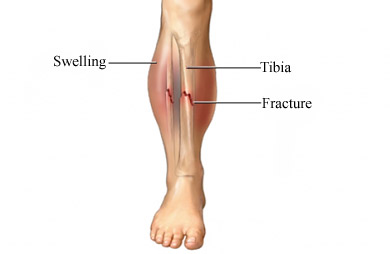Immediate Treatment for Tibia / Fibula Fractures
If you have fracture to the tibia or fibula or both, see a doctor immediately as the two bones are weight bearing bones. It will be good not to delay treatment. Immobilise the leg.
Brief Outline of Fractures (Tibia, Fibula)
Most human bones have outer shells of cortical bone, which means that the porosity is low, with cancellous bone underneath (high porosity). The cortical bone means that the structure is stiffer and capable of withstanding great stress. When the outer shell is cracked it is called a fracture. The bone may be either partially fractured or completely broken.
Anatomy and Physiology of Fractures (Tibia, Fibula)
The tibia (shin bone) is the larger and more medial of the bones in the lower leg. At the proximal end the medial and lateral condyles articulate with the distal end of the femur to form the knee joint. The tibial tuberosity is a roughened area on the anterior surface of the tibia. The fibula lies lateral and parallel to the tibia and is thin and sticklike. The fibula is not a weight bearing bone and plays no part in the knee joint, the tibia i the only weight bearing bone of the lower leg. Both bones meet at the ankle. Although either bone can be fractured alone, they are most commonly fractured together. Most fractures involve the proximal (near the knee), or distal (near the ankle) ends of the bone. Due to the thin covering of skin and other tissue over the tibia, these fractures are often open fractures, meaning the broken bone ends break the skin.
Cause of Fractures (Tibia, Fibula)
Direct force (impact) to the bones along the shaft or extreme loading of the bone, such as with a landing from a high fall. Rotational or indirect forces on the bones, e.g. tackle in football. Twisting, especially when the bone is under a load or when the foot is fixed.
Signs and Symptoms (Tibia, Fibula)
Pain, inability to walk or bear weight, and often inability to move the leg. Deformity may be present at the fracture site, or the fracture may be open. Swelling and tenderness.
Complications If Left Tibia / Fibula Fractures Unattended
Instability in the lower leg is one long-term complication of an untreated fracture. Blood vessel damage from a fracture can lead to internal bleeding and swelling as well as circulation problems for the foot. Nerve involvement can lead to serious problems such as drop foot or a loss of sensation in the lower leg and foot.
Rehabilitation and Prevention for Tibia / Fibula Fractures
After the fracture has healed, it will be necessary to rebuild the strength and flexibility of the muscles in the lower leg. Range of motion activities may be needed for the knee and ankle depending on the location of the fracture and the extent of immobilisation required. When the fracture has healed a gradual re-entry into activity must be observed to prevent re-injury. Strong calf and anterior tibialis muscles will help protect the tibia and fibula.
Long-term Prognosis for Tibia / Fibula Fractures
If set properly and allowed to heal fully, a fracture should not present any future problems. In some cases a rod or pins may be needed to hold the bones in place during healing. Surgery may be required in a few cases where blood vessel or nerve damage is severe.


